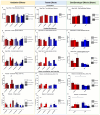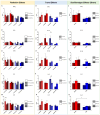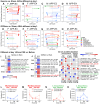Cognitive Effects of Simulated Galactic Cosmic Radiation Are Mediated by ApoE Status, Sex, and Environment in APP Knock-In Mice
- PMID: 39273325
- PMCID: PMC11394682
- DOI: 10.3390/ijms25179379
Cognitive Effects of Simulated Galactic Cosmic Radiation Are Mediated by ApoE Status, Sex, and Environment in APP Knock-In Mice
Abstract
Cosmic radiation experienced during space travel may increase the risk of cognitive impairment. While simulated galactic cosmic radiation (GCRsim) has led to memory deficits in wildtype (WT) mice, it has not been investigated whether GCRsim in combination with genetic risk factors for Alzheimer's disease (AD) worsens memory further in aging mice. Here, we investigated the central nervous system (CNS) effects of 0 Gy (sham) or 0.75 Gy five-ion GCRsim or 2 Gy gamma radiation (IRR) in 14-month-old female and male APPNL-F/NL-F knock-in (KI) mice bearing humanized ApoE3 or ApoE4 (APP;E3F and APP;E4F). As travel to a specialized facility was required for irradiation, both traveled sham-irradiated C57BL/6J WT and KI mice and non-traveled (NT) KI mice acted as controls for potential effects of travel. Mice underwent four behavioral tests at 20 months of age and were euthanized for pathological and biochemical analyses 1 month later. Fecal samples were collected pre- and post-irradiation at four different time points. GCRsim seemed to impair memory in male APP;E3F mice compared to their sham counterparts. Travel tended to improve cognition in male APP;E3F mice and lowered total Aβ in female and male APP;E3F mice compared to their non-traveled counterparts. Sham-irradiated male APP;E4F mice accumulated more fibrillar amyloid than their APP;E3F counterparts. Radiation exposure had only modest effects on behavior and brain changes, but travel-, sex-, and genotype-specific effects were seen. Irradiated mice had immediate and long-term differences in their gut bacterial composition that correlated to Alzheimer's disease phenotypes.
Keywords: APP mouse models; Alzheimer’s disease; apolipoprotein E; galactic cosmic radiation; gamma radiation; gut microbiome; sex differences.
Conflict of interest statement
D.M.H. is a co-founder with equity of C2N Diagnostics and is on the scientific advisory board of Genentech, C2N Diagnostics, Denali, Cajal Neurosciences, and Asteroid. C.A.L. serves as a paid scientific advisor for Acumen Pharmaceuticals, ADvantage Therapeutics, Alnylam Pharmaceuticals, Apellis Pharmaceuticals, Cyclo Therapeutics, Merck, Novo Nordisk, and Sanofi-Genzyme and receives research funding from the National Institutes of Health (NIH), NASA, and the Cure Alzheimer’s Fund. All the other authors declare no conflicts of interest.
Figures









Similar articles
-
Amyloid-β plaque formation and reactive gliosis are required for induction of cognitive deficits in App knock-in mouse models of Alzheimer's disease.BMC Neurosci. 2019 Mar 20;20(1):13. doi: 10.1186/s12868-019-0496-6. BMC Neurosci. 2019. PMID: 30894120 Free PMC article.
-
Long-Term, Sex-Specific Effects of GCRsim and Gamma Irradiation on the Brains, Hearts, and Kidneys of Mice with Alzheimer's Disease Mutations.Int J Mol Sci. 2024 Aug 16;25(16):8948. doi: 10.3390/ijms25168948. Int J Mol Sci. 2024. PMID: 39201636 Free PMC article.
-
Cognitive and emotional alterations in App knock-in mouse models of Aβ amyloidosis.BMC Neurosci. 2018 Jul 28;19(1):46. doi: 10.1186/s12868-018-0446-8. BMC Neurosci. 2018. PMID: 30055565 Free PMC article.
-
Sexual dimorphism, altered hippocampal glutamatergic neurotransmission, and cognitive impairment in APP knock-in mice.J Alzheimers Dis. 2024 Nov;102(2):491-505. doi: 10.3233/JAD-240795. Epub 2024 Nov 14. J Alzheimers Dis. 2024. PMID: 39543985
-
Apolipoprotein E genotype-dependent accumulation of amyloid β in APP-knock-in mouse model of Alzheimer's disease.Biochem Biophys Res Commun. 2023 Nov 26;683:149106. doi: 10.1016/j.bbrc.2023.10.038. Epub 2023 Oct 10. Biochem Biophys Res Commun. 2023. PMID: 37857162
References
-
- Cucinotta F.A., Kim M.-H.Y., Ren L. Evaluating shielding effectiveness for reducing space radiation cancer risks. Radiat. Meas. 2006;41:1173–1185. doi: 10.1016/j.radmeas.2006.03.011. - DOI
-
- United Nations Scientific Committee on the Effects of Atomic Radiation . Sources and Effects of Ionizing Radiation: United Nations Committee of the Effects of Atomic Radiation UNSCEAR 2000 Report to the General Assembly, with Scientific Annexes. U.N.; New York, NY, USA: 2000.
-
- Hassler D.M., Zeitlin C., Wimmer-Schweingruber R.F., Ehresmann B., Rafkin S., Eigenbrode J.L., Brinza D.E., Weigle G., Böttcher S., Böhm E., et al. Mars’ surface radiation environment measured with the Mars Science Laboratory’s Curiosity rover. Science. 2014;343:1244797. doi: 10.1126/science.1244797. - DOI - PubMed
MeSH terms
Substances
Grants and funding
LinkOut - more resources
Full Text Sources
Medical
Molecular Biology Databases
Research Materials
Miscellaneous

